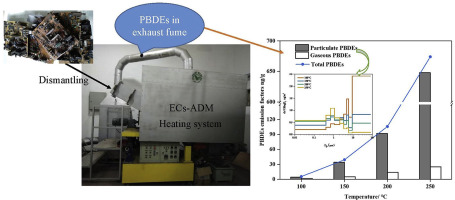当前位置:
X-MOL 学术
›
Atmos. Environ.
›
论文详情
Our official English website, www.x-mol.net, welcomes your feedback! (Note: you will need to create a separate account there.)
Emission characteristics of polybrominated diphenyl ethers from the thermal disassembly of waste printed circuit boards
Atmospheric Environment ( IF 5 ) Pub Date : 2020-04-01 , DOI: 10.1016/j.atmosenv.2020.117402 Shufei Tan , Zhenyu Chen , Rui Wang , Jie Guo , Zhenming Xu
Atmospheric Environment ( IF 5 ) Pub Date : 2020-04-01 , DOI: 10.1016/j.atmosenv.2020.117402 Shufei Tan , Zhenyu Chen , Rui Wang , Jie Guo , Zhenming Xu

|
Abstract Thermal disassembly is prevalently applied for the removal of electronic components on waste printed circuit boards (WPCBs), and temperature is an important factor influencing the pollutant emission process. The emission characteristics of polybrominated diphenyl ethers (PBDEs) to the environment under thermal stress were investigated by conducting both bench-scale experiments and pilot-scale experiments over a temperature range from 100 to 260 °C. Bench-scale experiments showed that the emission factors (EFs) for ∑39PBDEs from WPCB powder were obviously higher than those from WPCB fragments. Mono-to tri-BDEs predominated the PBDEs emission at each temperature, and the EFs for the mono-to tri-BDEs from WPCB powder ranged from 232 to 3280 ng/g, respectively. Pilot-scale experiments were done to study the particulate matter (PM) and PBDEs emitted from WPCBs mounted with electronic components using a thermal disassembly machine. The mass of the PM and PBDEs released from WPCBs during heating increased with increasing temperature. A bimodal distribution pattern for the PM with peaks at diameters of 0.4–0.7 and 5.8–9.0 μm was observed. The values of the EFs for ∑39PBDEs varied from 6.41 to 674 ng/g, which were comparable with those calculated from WPCB fragments in the bench-scale experiments. The mass distribution of the ∑39PBDEs in the PM predominated in the size fraction of >9.0 μm and 0.7–1.1 μm at 100 and 260 °C, respectively. The highly brominated PBDEs (hexa- and hepta-BDEs) had a mass median aerodynamic diameter (MMAD) greater than 2.5 μm, while the lightly brominated PBDEs (mono-to penta-BDEs) were mainly distributed in finer particles, with a MMAD of less than 2.5 μm. The particle size distribution of PBDEs was significantly correlated with the distribution of organic carbon (OC) in PM. All these results can provide basic data for gas pollution related to PBDEs and its control for electronic waste recycling.
中文翻译:

废印刷电路板热分解多溴联苯醚的排放特性
摘要 热拆卸普遍用于去除废印刷电路板(WPCB)上的电子元件,温度是影响污染物排放过程的重要因素。通过在 100 到 260 °C 的温度范围内进行实验室规模实验和中试规模实验,研究了多溴联苯醚 (PBDEs) 在热应力下对环境的排放特性。实验室规模的实验表明,来自 WPCB 粉末的 ∑39PBDEs 的排放因子 (EF) 明显高于来自 WPCB 碎片的排放因子。单溴二苯醚到三溴二苯醚在每个温度下的多溴二苯醚排放占主导地位,WPCB 粉末中单溴二苯醚和三溴二苯醚的 EF 范围分别为 232 至 3280 ng/g。进行了中试规模的实验,以研究使用热分解机安装电子元件的 WPCB 排放的颗粒物 (PM) 和多溴二苯醚。WPCBs 在加热过程中释放的 PM 和 PBDEs 的质量随着温度的升高而增加。观察到 PM 的双峰分布模式,在直径为 0.4-0.7 和 5.8-9.0 μm 处具有峰值。∑39PBDE 的 EF 值从 6.41 到 674 ng/g 不等,这与在实验室规模实验中根据 WPCB 碎片计算的值相当。PM 中 ∑39PBDE 的质量分布在 100 和 260 °C 下分别以 >9.0 μm 和 0.7-1.1 μm 的尺寸分数为主。高度溴化的多溴二苯醚(六溴和七溴二苯醚)的质量中值空气动力学直径(MMAD)大于 2.5 μm,而轻度溴化的多溴二苯醚(mono-topenta-BDEs)主要分布在更细的颗粒中,MMAD小于2.5μm。PBDEs 的粒径分布与 PM 中有机碳 (OC) 的分布显着相关。所有这些结果都可以为PBDEs相关的气体污染及其对电子废物回收的控制提供基础数据。
更新日期:2020-04-01
中文翻译:

废印刷电路板热分解多溴联苯醚的排放特性
摘要 热拆卸普遍用于去除废印刷电路板(WPCB)上的电子元件,温度是影响污染物排放过程的重要因素。通过在 100 到 260 °C 的温度范围内进行实验室规模实验和中试规模实验,研究了多溴联苯醚 (PBDEs) 在热应力下对环境的排放特性。实验室规模的实验表明,来自 WPCB 粉末的 ∑39PBDEs 的排放因子 (EF) 明显高于来自 WPCB 碎片的排放因子。单溴二苯醚到三溴二苯醚在每个温度下的多溴二苯醚排放占主导地位,WPCB 粉末中单溴二苯醚和三溴二苯醚的 EF 范围分别为 232 至 3280 ng/g。进行了中试规模的实验,以研究使用热分解机安装电子元件的 WPCB 排放的颗粒物 (PM) 和多溴二苯醚。WPCBs 在加热过程中释放的 PM 和 PBDEs 的质量随着温度的升高而增加。观察到 PM 的双峰分布模式,在直径为 0.4-0.7 和 5.8-9.0 μm 处具有峰值。∑39PBDE 的 EF 值从 6.41 到 674 ng/g 不等,这与在实验室规模实验中根据 WPCB 碎片计算的值相当。PM 中 ∑39PBDE 的质量分布在 100 和 260 °C 下分别以 >9.0 μm 和 0.7-1.1 μm 的尺寸分数为主。高度溴化的多溴二苯醚(六溴和七溴二苯醚)的质量中值空气动力学直径(MMAD)大于 2.5 μm,而轻度溴化的多溴二苯醚(mono-topenta-BDEs)主要分布在更细的颗粒中,MMAD小于2.5μm。PBDEs 的粒径分布与 PM 中有机碳 (OC) 的分布显着相关。所有这些结果都可以为PBDEs相关的气体污染及其对电子废物回收的控制提供基础数据。



























 京公网安备 11010802027423号
京公网安备 11010802027423号